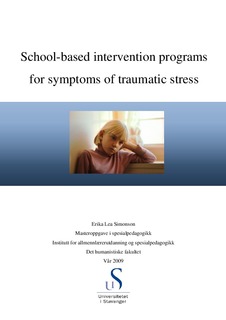| dc.description.abstract | This thesis attempts to provide an up-to-date overview of school-based intervention programs for symptoms of traumatic stress. The objectives were: 1) to identify school-based intervention programs for preventing or reducing symptoms of traumatic stress, 2) to examine the effectiveness of the intervention programs, and 3) to identify the accordance of the intervention programs with three current theories of posttraumatic stress disorder (PTSD). The three main academic databases used to locate the studies for this thesis were ERIC, PsycINFO, and MEDLINE. Inclusionary/exclusionary criteria included: 1) use of a control group, 2) use of randomized/quasi-experimental design, 3) school setting, 4) participant exposure to a traumatic event, 5) targeted at the prevention/ reduction of symptoms of traumatic stress, 6) use of standardized instruments, and 7) not targeted Type II trauma. Using these criteria, 19 studies conducted in 11 different countries were selected. Unfortunately, school-based studies conducted in Norway were not located. The selected studies dealt with various types of trauma exposure such as natural disasters, community violence, and war. Fourteen of the studies used cognitive-behavioral therapy (CBT) methods as the main treatment approach. Other treatment approaches used included Eye Movement Desensitization and Reprocessing (EMDR), mind-body techniques (e.g., guided imagery, relaxation techniques, and meditation), play therapy, art therapy, and drama. The findings of this thesis suggest that intervention provided within the school setting can be effective in helping children and adolescents following a variety of traumatic events. The majority of the studies had good results in relation to reducing symptoms of PTSD. Of the 19 studies, 14 had effect sizes in the medium to large range. Most of the intervention programs were found to be in accordance with the treatment recommendations of the three theories presented; however, none appeared to be explicitly based on the theories. | en |
